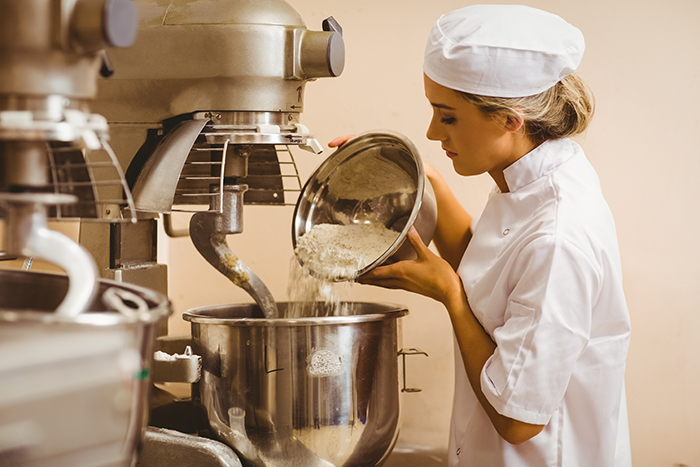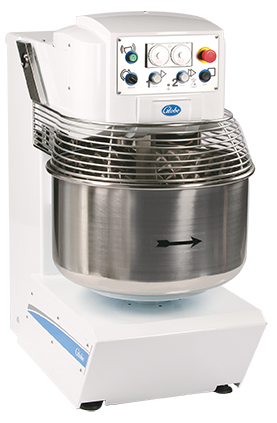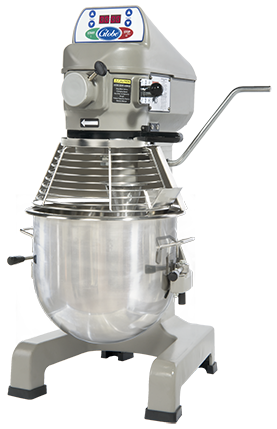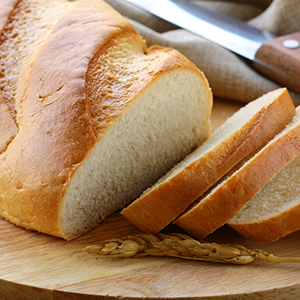
A commercial mixer is a necessity for most types of foodservice establishments. Primary mixer options are spiral and planetary. Deciding the style that best fits your production needs is dependent on the products being made.
Spiral

The function of a spiral mixer is to gently and efficiently mix dough, allowing proper development of the gluten structure while not overworking the ingredients. While the unit does not have the versatility of a planetary mixer, it produces a higher-quality product that is invaluable to establishments such as bakeries and pizzerias.
The bowl of a spiral mixer swivels and turns the dough into the rotating hook for optimal kneading. The synchronization of the hook and bowl allows for ideal mixing for the desired outcome. Multiple speeds also facilitate development. For Globe mixers, the first speed (low) brings the mixture together in a homogenous mass, while the second speed (high) develops the gluten structure.
During the kneading process, a breaker bar divides the dough, allowing only a portion to pass through the hook. Splitting in this manner is beneficial for keeping friction low and providing an even combination of ingredients.
Globe spiral mixers are for dough functions such as pizzas, bread loafs, bagels, etc. Both models can create batches as small as 25% of their capacity. The GSM130 can prepare 33 lbs. and up to 130 lbs. of dough while the GSM175 can prepare as little as 42 lbs. and up to 175 lbs. Choosing between the two depends entirely on your batch size requirements.
The bowl and hook are fixed and cannot be removed so cleaning must occur at the mixer location.
Planetary

Planetary mixers are more versatile. They are often referred to as “all-purpose” mixers. They can prepare everything from sauces, frosting and mashed potatoes to cookie, pizza and bread doughs. The removable whip, beater and hook attachments allow for much more flexibility in mixing. The bowl remains stationary as the hook rotates while also circling around the bowl (much like a planet rotating on its axis and around the sun).
Globe planetary mixers add further flexibility by way of the hub attachments. Your mixer can become a timesaving, high-volume food processor for cutting, slicing, shredding, grinding and tenderizing a variety of meats, cheeses, fruits and vegetables. Cleanup is also more efficient by removing the bowl and agitator and washing them in the sink or dish machine.
Summary: Spiral vs Planetary
Spiral: Higher capacity and superior dough product
Planetary: More flexibility and easy cleaning
SP62P
A specialty mixer specifically designed for high-volume pizza dough applications. It has two speeds; first speed is optimal for mixing dough while second speed is provided for higher volume hub attachment usage. This heavy-duty workhorse is designed to handle full 50 lb bags of flour.
SP62P-4
Has four fixed speeds for multipurpose use. It comes with a bowl, dough hook, flat beater, stainless steel whip and bowl truck.
SP80PL
Also has four fixed speeds for more adaptable function. This model includes a bowl, beater, hook, whip, timer and #12 hub.
Additional Accessories for Globe Planetary Mixers:
-
Bowl Scrapers
-
Adapter Kits
-
Housing for #12 Hub
-
Adjustable Slicing Plate
-
Shredding/Grating Plates/Plate Holder
-
Meat Grinder
-
Bowl Truck
-
Stainless Steel Table
-
Stainless Steel Beaters and Hooks
-
Stainless Steel Aileron Whip (A-Whip)
-
Mixer Cover
-
Meat Tenderizer
Homemade White Bread

Recipe: crazyforcrust.com/easy-white-bread
Ingredients:
-
2 packets (4 ½ teaspoons) Fleishmann’s RapidRise Yeast
-
5 ¾ cups all-purpose flour
-
3 tablespoons granulated sugar
-
2 teaspoons salt
-
1 ½ cups water
-
½ cup milk
-
2 tablespoons butter
Directions:
-
Combine 2 cups flour, sugar, dry yeast and salt in the bowl of a stand mixer and stir until blended. Combine water, milk and butter in a microwave-safe bowl. Microwave on HIGH in 15-second increments until very warm but not hot to the touch (120° to 130°F. Butter won’t melt completely). Recommended to use an instant-read thermometer. Add to flour mixture.
-
Beat 2 minutes at medium speed, scraping bowl occasionally. Add 1 cup flour; beat 2 minutes at high speed, scraping bowl occasionally. Stir in just enough remaining flour so that the dough will form into a ball.
-
Knead on lightly floured surface until smooth and elastic and springs back when lightly pressed with 2 fingers, about 6 to 8 minutes. Cover with a towel; let rest for 10 minutes.
-
Cut dough into 2 equal pieces. Roll each piece of dough into a 12 x 7 inch rectangle using a rolling pin.
-
Beginning at short end of each rectangle, roll up tightly. Pinch seams and ends to seal. Place, seam sides down, in two 8 1/2 x 4 1/2 inch loaf pans that have been sprayed with nonstick cooking spray. Cover with towel; let rise in warm place until doubled in size, about 45 minutes.
-
Bake in preheated 400°F oven for 20 to 30 minutes or until golden brown. Remove from pans by running a knife around the edges and invert onto wire rack to cool.